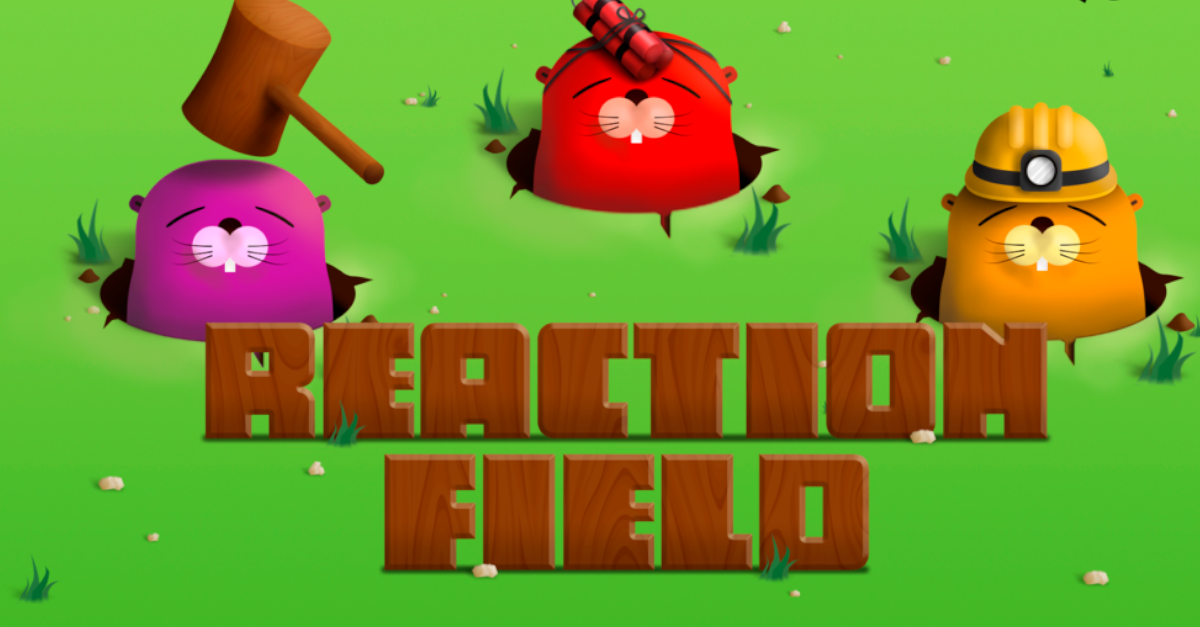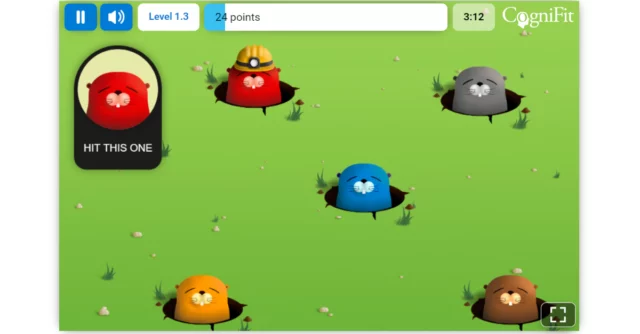
Reaction Field – Smack Those Sneaky Moles!
Have you ever played Whack-A-Mole? If not, you most certainly have heard of it!
And isn’t it one of the most satisfying games ever? Taking one of those big mallets and bopping those burrowing fuzzballs back into the ground to blow off a bit of frustration. Oh yes, please!
But “Reaction Field” isn’t the stress-reliever the original is – although if you want it to be, there’s nothing stopping you.
Instead, this simple game works with different mechanics to help improve three cognitive functions: Inhibition, Response Time, and Shifting.
Let’s look at how the game works and how it exercises the brain.
How to Play Reaction Field
The start screen is the usual CogniFit design. On the right side of the screen, you’ll find an upside-down tear drop. You can move it back and forth to choose the level of difficulty.
With all games, it’s a good idea to start low and work your way up. This is because high levels are a REAL challenge.
On the screen, you’ll see a few colorful, happy moles sticking out of the ground. And, in the top left corner, there’s a small window telling you which one to bop on the head. Just click on the little guy, let the mallet do the rest, and move on to the next target.

However, it will be tempting to “zone out” – meaning gloss over your field of vision so you can “see more” without having to dart your eyes around.
Don’t do this – you’ll be taking away a critical aspect of the game and therefore one of the key brain functions you’re trying to strengthen.
As levels get harder, there will be more moles and less time. Also, some will have a pile of dynamite tied to their heads. Don’t hit these! Finally, a few will have hard hats. They need a double-whack to count as a hit. On the hardest level, you can only imagine the chaos!
Inhibition
If we were to boil this function down to one idea, it would be the ability to control your actions. Granted, there’s more to it than that, but for the sake of today’s rundown, let’s keep things simple.
People with good inhibition, don’t lose their temper while driving. They are also excellent planners. They have mastery over impulses and are fantastic at anticipating what could happen in any given situation. But what’s surprising is that they are far more positive people and less prone to bad habits.
In Reaction Field, someone might have the urge to click all over the place in hopes of getting one right. But that doesn’t help the brain. Taking your time (within whatever time restraints you have) and looking for the right target, helps develop the skill of Inhibition.
Response Time
This is also called reaction time – basically the time it takes between perceiving something and reacting to it appropriately.
However, having a “good or poor” response time isn’t as cut and dry as you think. It all depends on…
- The complexity of the stimulus – the more complex, the harder to process
- How familiar you are with it – the more familiar, the slower the response time
- The state you’re in – eg. if you’re sleepy you’ll respond slower
- The sense that gets the stimulus – eg. auditory input processes faster than visual
Reaction Field’s speed limits test and help to create better reaction times in your brain. The stimulus is simple (just images) so the countdown clock can be the focus.

Shifting
Cognitive shifting is the brain’s ability to adapt your behavior and thoughts to new, changing, or unexpected events. In other words, shifting is the ability to see that what you’re doing isn’t working and make the appropriate changes to adapt to new situations.
If you have great Shifting, you’re excellent at problem-solving, tolerate changes easily, switch tasks with ease, can see other points of view with no problem, and have high levels of empathy.
It’s no wonder that it’s part of our brain’s Executive Functions – the collection of cognitive abilities that let up plan and achieve goals. However, even if our Shifting levels are solidified by the time we are 20, that doesn’t mean we can’t do cognitive training to nurture and branch out more neural pathways.
And in the case of Reaction Time, as we take our time and climb the levels of difficulty, we will have to adapt to the new challenges we are presented with to push those fuzzy moles back into their homes.
Conclusion
This is a wonderfully fun game that anyone would love to add to their mental exercise regime.
And, if you’re new to brain games, there’s some great news! All it takes is 20 minutes per session and 3 sessions per week. So, why not give it a try? Or head over to CogniFit and see the rest of our amazing games.












